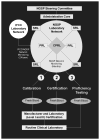The long and winding road to optimal HbA1c measurement
- PMID: 23318564
- PMCID: PMC4762213
- DOI: 10.1016/j.cca.2012.12.026
The long and winding road to optimal HbA1c measurement
Abstract
The importance of hemoglobin A1c (HbA1c) as an indicator of mean glycemia and risks for complications in patients with diabetes mellitus was established by the results of long-term clinical trials, most notably the Diabetes Control and Complications Trial (DCCT) and United Kingdom Prospective Diabetes Study (UKPDS), published in 1993 and 1998 respectively. However, clinical application of recommended HbA1c targets that were based on these studies was difficult due to lack of comparability of HbA1c results among assay methods and laboratories. Thus, the National Glycohemoglobin Standardization Program (NGSP) was initiated in 1996 with the goal of standardizing HbA1c results to those of the DCCT/UKPDS. HbA1c standardization efforts have been highly successful; however, a number of issues have emerged on the "long and winding road" to better HbA1c, including the development of a higher-order HbA1c reference method by the International Federation of Clinical Chemistry (IFCC), recommendations to use HbA1c to diagnose as well as monitor diabetes, and point-of-care (POC) HbA1c testing. Here, we review the past, present and future of HbA1c standardization and describe the current status of HbA1c testing, including limitations that healthcare providers need to be aware of when interpreting HbA1c results.
Copyright © 2013 Elsevier B.V. All rights reserved.
Figures




References
-
- World Health Organization. WHO Diabetes Media centre. 2012.
-
- DCCT Research Group. The effect of intensive treatment of diabetes on the development and progression of long term complications in insulin dependent diabetes mellitus. New Engl J Med. 1993;329:977–986. - PubMed
-
- UK Prospective Diabetes Study (UKPDS) Group. Intensive blood-glucose control with sulphonylureas or insulin compared with conventional treatment and risk of complications in patients with type 2 diabetes (UKPDS 33) Lancet. 1998;352:837–851. - PubMed
-
- Baynes JW, Bunn HF, Goldstein D, et al. National Diabetes Data Group: report of the expert committee on glucosylated hemoglobin. Diabetes Care. 1984;7:602–606. - PubMed
-
- Little RR, Wiedmeyer HM, England JD, Naito HK, Goldstein DE. Interlaboratory comparison of glycohemoglobin results: College of American Pathologists Survey data. Clin Chem. 1991;37:1725–1729. - PubMed
Publication types
MeSH terms
Substances
Grants and funding
LinkOut - more resources
Full Text Sources
Other Literature Sources
Medical
Miscellaneous

